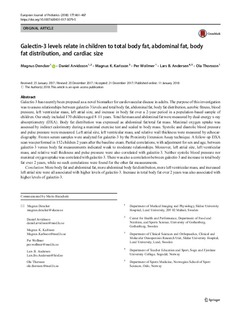| dc.contributor.author | Dencker, Magnus | |
| dc.contributor.author | Arvidsson, Daniel | |
| dc.contributor.author | Karlsson, Magnus K. | |
| dc.contributor.author | Wollmer, Per | |
| dc.contributor.author | Andersen, Lars Bo | |
| dc.contributor.author | Thorsson, Ola | |
| dc.date.accessioned | 2019-04-26T09:23:20Z | |
| dc.date.available | 2019-04-26T09:23:20Z | |
| dc.date.created | 2018-07-16T10:10:41Z | |
| dc.date.issued | 2018 | |
| dc.identifier.citation | European Journal of Pediatrics. 2018, 177, 461-467. | nb_NO |
| dc.identifier.issn | 0340-6199 | |
| dc.identifier.uri | http://hdl.handle.net/11250/2595656 | |
| dc.description | This article is an open access publication | nb_NO |
| dc.description.abstract | Galectin-3 has recently been proposed as a novel biomarker for cardiovascular disease in adults. The purpose of this investigation was to assess relationships between galectin-3 levels and total body fat, abdominal fat, body fat distribution, aerobic fitness, blood pressure, left ventricular mass, left atrial size, and increase in body fat over a 2-year period in a population-based sample of children. Our study included 170 children aged 8–11 years. Total fat mass and abdominal fat were measured by dual-energy x-ray absorptiometry (DXA). Body fat distribution was expressed as abdominal fat/total fat mass. Maximal oxygen uptake was assessed by indirect calorimetry during a maximal exercise test and scaled to body mass. Systolic and diastolic blood pressure and pulse pressure were measured. Left atrial size, left ventricular mass, and relative wall thickness were measured by echocardiography. Frozen serum samples were analyzed for galectin-3 by the Proximity Extension Assay technique. A follow-up DXA scan was performed in 152 children 2 years after the baseline exam. Partial correlations, with adjustment for sex and age, between galectin-3 versus body fat measurements indicated weak to moderate relationships. Moreover, left atrial size, left ventricular mass, and relative wall thickness and pulse pressure were also correlated with galectin-3. Neither systolic blood pressure nor maximal oxygen uptake was correlated with galectin-3. There was also a correlation between galectin-3 and increase in total body fat over 2 years, while no such correlations were found for the other fat measurements.
Conclusion: More body fat and abdominal fat, more abdominal body fat distribution, more left ventricular mass, and increased left atrial size were all associated with higher levels of galectin-3. Increase in total body fat over 2 years was also associated with higher levels of galectin-3. | nb_NO |
| dc.language.iso | eng | nb_NO |
| dc.subject | DXA | nb_NO |
| dc.subject | body fat | nb_NO |
| dc.subject | children | nb_NO |
| dc.subject | galectin-3 | nb_NO |
| dc.title | Galectin-3 levels relate in children to total body fat, abdominal fat, body fat distribution, and cardiac size | nb_NO |
| dc.title.alternative | Galectin-3 levels relate in children to total body fat, abdominal fat, body fat distribution, and cardiac size | nb_NO |
| dc.type | Journal article | nb_NO |
| dc.type | Peer reviewed | nb_NO |
| dc.description.version | publishedVersion | nb_NO |
| dc.rights.holder | © The Author(s) 2018 | nb_NO |
| dc.source.pagenumber | 461-467 | nb_NO |
| dc.source.volume | 177 | nb_NO |
| dc.source.journal | European Journal of Pediatrics | nb_NO |
| dc.source.issue | 3 | nb_NO |
| dc.identifier.doi | 10.1007/s00431-017-3079-5 | |
| dc.identifier.cristin | 1597399 | |
| dc.description.localcode | Seksjon for idrettsmedisinske fag / Department of Sports Medicine | nb_NO |
| cristin.unitcode | 150,34,0,0 | |
| cristin.unitname | Seksjon for idrettsmedisinske fag | |
| cristin.ispublished | true | |
| cristin.fulltext | original | |
| cristin.qualitycode | 1 | |
